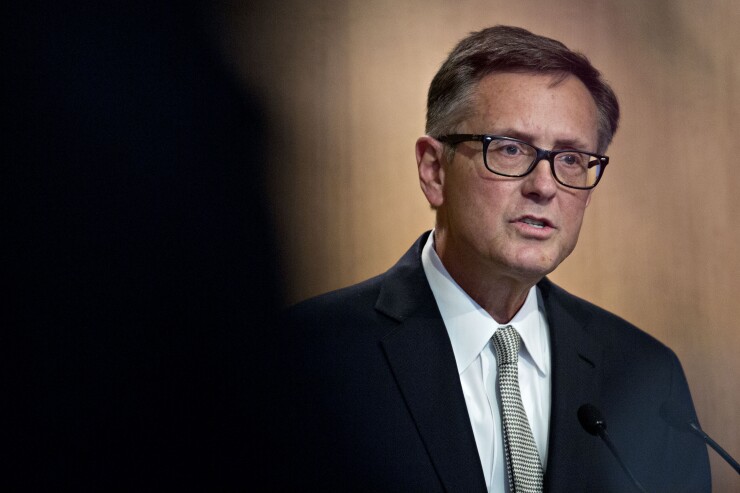The Federal Reserve took center stage again Friday, with two presidents explaining why they dissented at the latest meeting and Vice Chair Richard Clarida terming it “healthy” debate while talking up economic resilience.
In a televised interview Clarida said the panel in general believed a cut “was appropriate” and that debate is “healthy.” While the U.S. economy remains “in a good place,” he said the committee reacted to a slowing global economy, of which trade policy plays a role, and dis-inflationary pressures, all of which “have been getting worse since the beginning of the year.”

While the economy has shown “solid momentum,” the Fed’s decision “comes down to risk management.” As for the possibility of another cut, Clarida said, “We’ll take this meeting by meeting.”
Federal Reserve Bank of St. Louis President Bullard said he wanted a 50 basis point cut at the FOMC meeting because “U.S. economic growth is expected to slow in the near horizon. Trade policy uncertainty remains elevated, U.S. manufacturing already appears in recession, and many estimates of recession probabilities have risen from low to moderate levels. Moreover, the yield curve is inverted, and our policy rate remains above government bond yields for nearly every country in the G-7.”
Additionally, inflation remains “some 40 to 60 basis points … below the FOMC’s 2% inflation target,” and is expected to continue to miss the target, despite the 25 basis point cut in July and the 25 basis point cut that was expected for the September meeting. “There is little evidence that low unemployment poses a significant inflation risk in the current environment,” Bullard said.
“I believe that lowering the target range for the federal funds rate by 50 basis points at this time would provide insurance against further declines in expected inflation and a slowing economy subject to elevated downside risks," Bullard said. "It is prudent risk management, in my view, to cut the policy rate aggressively now and then later increase it, should the downside risks not materialize. At the same time, a 50 basis point cut at this time would help promote a more rapid return of inflation and inflation expectations to target.”
Federal Reserve Bank of Boston President Eric S. Rosengren, who didn’t want a rate cut, said in a statement: “The stance of monetary policy is accommodative. Additional monetary stimulus is not needed for an economy where labor markets are already tight, and risks further inflating the prices of risky assets and encouraging households and firms to take on too much leverage. While risks clearly exist related to trade and geopolitical concerns, lowering rates to address uncertainty is not costless.”
He followed up during a speech at New York University, saying “economic data suggest continued expansion,” according to prepared text of the speech, released by the Fed. “It is not unusual to have a sequence of decreases in the federal funds rate when the economy is in an economic downturn, often when interest rates have become too contractionary and there is concern that the economy is slowing too much,” he said. “The data we have in hand suggest instead that the recovery would continue apace even with little monetary policy accommodation.”
Too much accommodation has costs and risks, he said, including “the potential buildup of financial instability.”
Any response to risks must be based “on how likely one thinks the outlook is to deteriorate, and by how much, and also what you believe are the likely costs of reducing rates. As I suggested a moment ago, so far the economy seems to have weathered the impact of trade disruptions and slowing foreign growth.”
He concluded: “Additional accommodation is not needed for an economy where labor markets are already tight – and risks further inflating the prices of riskier assets, and encouraging households and firms to take on what may be too much leverage.”
Data
Economic data on Thursday were generally better than expected.
The regional economy expanded, albeit at a slower pace, in September according to the Federal Reserve Bank of Philadelphia’s Business Outlook Survey. The general business condition index fell to 12.0 from 16.8 a month earlier, while the six months ahead index dropped to 20.8 from 32.6. The employment indices rose, as did the current price indexes.
Economists polled by IFR Markets expected an 11.0 reading.
The current account deficit narrowed to $128.2 billion in the second quarter from $136.2 billion in the first quarter, the Commerce Department said. The earlier deficit was first reported as $130.4 billion.
Economists expected a $127.5 billion shortage.
Initial jobless claims grew 2,000 to 208,000 in the week ended Sept. 14, the Labor Department said Thursday. The claims figure for the week ended Sept. 7 was 206,000. Continued jobless claims were 1.661 million in the week ended Sept. 7, down from 1.674 million the week before.
IFR Markets expected 212,000 initial claims and 1.672 million continued claims.
Existing-home sales rose for the second month in a row in August, rising to 5.49 million on a seasonally adjusted annual rate from 5.42 million a month earlier, according to the National Association of Realtors. Sales rose 2.6% year-over-year. Economists expected 5.38 million sales.
The Conference Board’s Leading Economic Index was flat in August, following a 0.4% increase in July, while the Coincident Index rose 0.3%, after a flat reading in July, and the lagging Index fell 0.3% in August, after a 0.6% gain the month before.
Economists expected a 0.1% rise.
“The recent trends in the LEI are consistent with a slow but still expanding economy, which has been primarily driven by strong consumer spending and robust job growth,” said Ataman Ozyildirim, senior director of economic research at The Conference Board.





